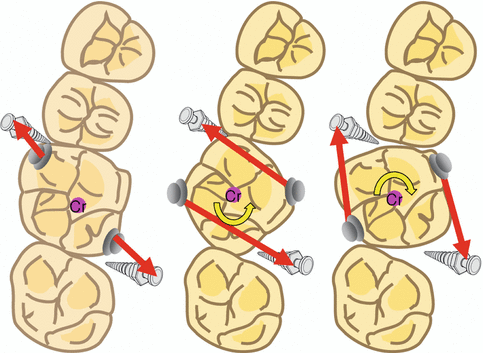Fig. 11.1
Estimated change in the overall masticatory function according to each procedure
11.2 POGS (Pre-orthodontic Orthognathic Surgery) and Prerequisites for Reliable POGS Procedure
The POGS (pre-orthodontic orthognathic surgery) refers to the orthognathic surgery conducted prior to any orthodontic tooth movement. Although the “surgery-first” approach has been introduced back in 2009 [6], this approach is not an entirely new technique, Epker and Fish stated that surgical procedures should be performed as early as possible in the overall treatment regimen [7, 8], and the strategic postsurgical leveling of the arch has already been proposed elsewhere, especially in hypodivergent cases [9].
An obvious and outstanding advantage of this procedure is that the patient gains a profile change at the initial phase of the treatment. Since the presurgical decompensation makes the profile even worse, the POGS effectively eliminates this phase. Other possible advantages such as reduction of treatment time via utilization of the so-called regional acceleration phenomenon are not proven yet [10, 11]. The regional acceleration originally refers to local bone formation confined to the fracture area for just a few weeks and does not necessarily apply to the remote areas [12]. For example, there is no evidence yet that the osteotomy site for maxillomandibular surgery would affect the bone turnover in the alveolar area. The extent and duration of the regional acceleration related to surgical trauma needs to be explained more empirically. In contrast, unstable postsurgical occlusion and unpredictable surgical stability may hinder orthodontic occlusal structuring and extend the treatment time.
Overall, it does not mean an orthognathic surgery without the need of any orthodontic intervention. It is simply the procedure where orthodontic decompensation is conducted after surgery, for which the following are crucial (Fig. 11.2):
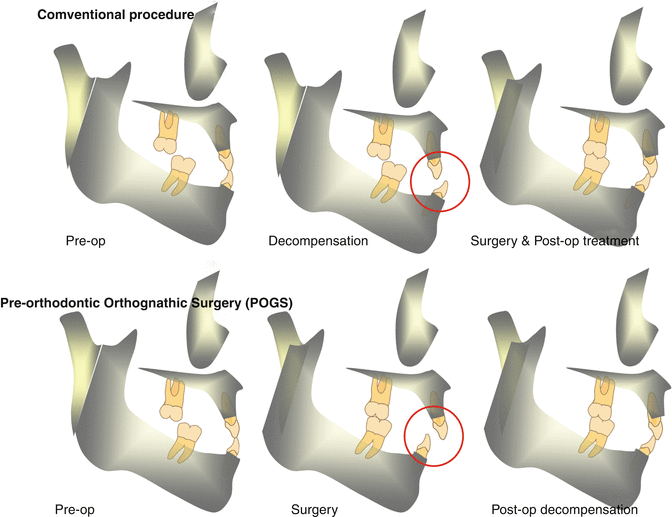

Fig. 11.2
Dental decompensation in conventional vs POGS protocol
1.
Appropriate assessment of the soft tissue with special regard to the midline
For the POGS procedure, the presurgical treatment period becomes minimal, and the required assessment has to be made beforehand to minimize the possible errors. In particular, evaluation of the facial (soft tissue) midline is the most important. The soft tissue structure can be affected by not only the underlying hard tissue but also its counterparts. For example, the upper philtrum line can be affected by mandibular movement and the movement of the lower incisor may displace the upper lip position. Therefore, a careful presurgical assessment is a must.
2.
Adequate prediction of postsurgical decompensation
It is not easy to precisely anticipate the pattern or amount to tooth movement. First, it is important to define the segment that has to be moved and the one that should not. Once the diagnosis is made adequately, application of miniscrews can minimize the errors by securing the anchorage segment. Previous information on the amount of possible tooth movement may help treatment planning, which will be explained further in this chapter.
3.
Appropriate surgical procedure that does not cause significant postsurgical relapse or change of basal bone
A majority of the POGS cases inevitably exhibit very unstable postsurgical occlusion. Reliable and accurate surgical movement is essential. Moreover, the key factor for a reliable surgical procedure is to secure the stability of bone segment after relocation. Unfortunately, orthognathic surgery is subject to a certain degree of relapse which can hardly be anticipated before surgery [13, 14]. It is not easy to point an appropriate surgical procedure for POGS. The two known procedures for mandibular surgery, SSRO and IVRO, differ in the attachment of the pterygomasseteric sling after surgery, i.e., at the proximal segment in SSRO and at the distal segment in IVRO [15]. Therefore, the operator needs to be careful in handling the respective segment. In SSRO, the main concern of the orthodontists is the position of the proximal segment, which could affect the jaw position. Unexpected condylar dislocation or resorption following SSRO can be detrimental [16]. In contrast, elongation or extension of the pterygomasseteric sling in IVRO can lead to significant relapse of the distal segment after Class III surgery. By freeing the proximal jaw segment without rigid fixation, the IVRO has been shown to be effective in reducing the temporomandibular symptoms following surgery [17]. If one is not convinced by the condylar positioning during surgery, the IVRO may be a reliable alternative for POGS. Under any circumstances, precision relocation of the bone segments and stabilization are crucial, and the surgeon and orthodontist should closely collaborate to minimize or eliminate the possible surgical relapse (Fig. 11.3).
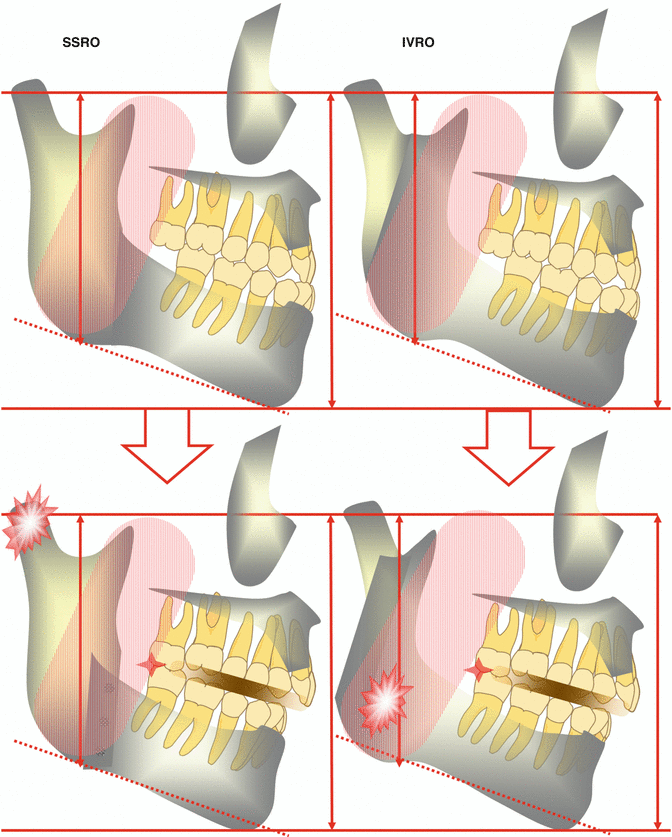

Fig. 11.3
Pattern of relocation of bone segments in SSRO and IVRO and respective attachment of pterygomasseteric sling
4.
Predictable tooth movement regardless of patients’ compliance
Following the surgery, the ability to move the teeth according to the plan is important. In view of the biomechanics, definition of the anchorage segment and moving segment is the key. Then the orthodontic movement is carried out according to the plan. Instead of inserting a continuous arch from the initial stage, planned movement of a specific segment or a target tooth greatly helps to minimize the unexpected tooth movement, named as round tripping. Another factor is the patients’ compliance. Since the compliance for such as intermaxillary elastics is always very unpredictable, it is better advised to use intra-arch mechanics. For this, the incorporation of miniscrews will significantly increase the success of POGS.
11.3 Characteristics of Surgery Occlusion in POGS
In most non-orthodontic patients with maxillomandibular skeletal discrepancies, the dental arches are not leveled. Therefore, it is natural that the irregularities along the occlusal plane would lead to occlusal interference at certain point(s) when surgical jaw relocation was conducted. Although the initial surgical occlusion may be extremely unstable, the muscle tension is not strong enough to cause skeletal relapse immediately after surgery. Hence, timely management of the occlusion is crucial in order to establish a stable occlusion during the initial phase of the postsurgical period.
11.4 The Role of TADs in POGS
Considering that the postsurgical occlusion after POGS, in most cases, presents intermaxillary interference at some point(s) due to the lack of presurgical orthodontic treatment, early settlement of the occlusion is crucial. However, unlike in the conventional orthognathic surgery cases, use of intermaxillary elastics is strongly avoided because the traction force may induce displacement of the proximal or distal segment of the surgically relocated maxillomandibular bones. Stable jaw position is essential for reliable POGS procedure. Therefore, instead of intermaxillary orthodontic mechanics, intra-arch mechanics is preferred for the decompensation of the denture, for which interradicular miniscrews can be very helpful since they do not require tooth anchorage (Fig. 11.4).
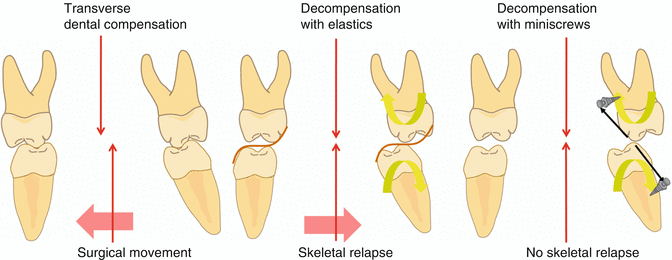

Fig. 11.4
Immediately after POGS, the occlusion is largely unstable. In case of asymmetry, the directions of the surgical relapse and the denture decompensation are opposite to each other. Intermaxillary elastics used for the transverse decompensation of the denture may lead to the relapse of the relocated bones. The transverse decompensation must be done without affecting the underlying bone using an anchorage device targeting the segment to be decompensated
11.5 Postsurgical Decompensation
Postsurgical decompensation is carried out in all three spatial planes – anteroposterior, vertical, and transverse – and it is known that a change in one dimension affects the others [1]. For example, a transverse change would influence overall vertical dimension, and a hinge closure of the mandibular body will affect the relative anteroposterior relation of the upper and lower counterparts. Therefore, it is advised to plan a stepwise orthodontic strategy following surgery. For example, an establishment of a desired vertical dimension would have to precede anteroposterior decompensation. In each dimension, the miniscrews are indicated at “inconsistent” situations (Fig. 11.5):
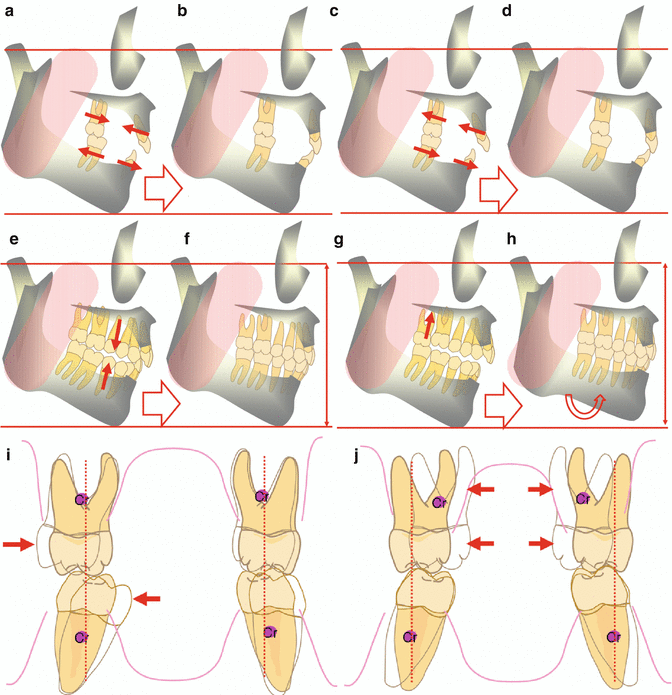

Fig. 11.5
Decompensation strategies and indication for miniscrews. (a, b) AP decompensation via reciprocal movement – miniscrews are not indicated, (c, d) AP decompensation via total arch movement – miniscrews are indicated. (e, f) Vertical decompensation via extrusion – miniscrews are not indicated. (g, h) Vertical decompensation via selective intrusion – miniscrews are indicated. (i) Transverse decompensation without absolute transverse deficiency – miniscrews are indicated, (j) Transverse decompensation with absolute transverse deficiency – transverse issue has to be resolved via surgical or nonsurgical measures, including miniscrew-assisted RPE
1.
Anteroposterior decompensation
On the sagittal plane, on a given basal bone relationship, the posterior and anterior segments may be moved to the opposite direction by reciprocal action. Alternatively, when the posterior and anterior segments have to move in the same direction, additional skeletal anchorage devices would be necessary, for which miniscrews are indicated and intermaxillary elastics are contraindicated as has been explained.
2.
Vertical decompensation
Vertical decompensation can be performed either by extrusive or intrusive measures [1]. Either Class II or Class III hypodivergent face with deep curve of Spee and deep overbite tends to leave excessive intermaxillary space between the anterior and posterior occlusal contacts, following the relocation of jawbones. According to the conventional guideline, intermaxillary elastics worn along the path of hinge closure would lead to selective extrusion of premolars and flatten the curve of Spee without deterioration of the overall vertical dimension [9]. In contrast, generalized open bite caused by extrusion of a specific tooth can be resolved by a selective intrusion of the target tooth, which can be easily attained by using miniscrew(s). Particularly, intrusive vertical decompensation leads to the closure of a mandibular body and reduction of the anterior facial height.
3.
Transverse decompensation
Many skeletal asymmetry cases have transversely compensated molars, which have to be decompensated after surgery [18]. When there is a transverse issue, one has to preliminarily define whether the problem is a relative or an absolute maxillary deficiency [1, 19]. Transverse decompensation without an absolute maxillary deficiency can be easily resolved with the use of miniscrews. In case of absolute maxillary deficiency, however, expansion of the basal bone with an appropriate device or a procedure should precede the next step, since the transverse dimension is not easy to correct and it affects both vertical and anteroposterior dimension [20, 21].
11.6 Useful Mechanics for Predictable Tooth Movement
Since the interradicular miniscrews and elastic chains introduce relatively constant intrusive force vector(s) [22], intrusive mechanics for effective intrusion of extruded tooth or teeth is necessary. The monocortical miniscrew-type TADs are used for the following purposes:
1.
Single tooth intrusion
In many of the skeletal Class III patients, the maxillary second molars tend to be extruded due to the lack of occlusal contact with their mandibular counterpart. In particular, a prominent palatal cusp may hinder adequate interdigitation between the surgically relocated jaw segments. In terms of occlusal settling, selective intrusion of the extruded tooth or cusp can be more efficient than the overall extrusion of the rest teeth in the arch. Either a palatal or buccal interradicular miniscrew would induce rotational intrusion of the target tooth. In order to induce pure intrusion along the vertical axis of the tooth, bilateral miniscrews are helpful (Fig. 11.6).
2.
Buccolingual tipping of a single tooth
Transverse compensation of the dental arch is commonplace especially in the skeletal asymmetry, with typical buccal inclination of the maxillary posterior segment and lingual inclination of the mandibular segment and vice versa, in the respective deviated side of the chin point and the opposite side. This uneven inclination of the buccal segment results in unilateral contact occlusion after POGS procedure, for which early transverse decompensation without causing shifting the basal bone is crucial. The surgery occlusion is established with unequal buccal overjet between the deviated and opposite side, and the immediate decompensation is conducted using either palatal interradicular miniscrew(s) in the maxilla and/or buccal interradicular miniscrews in the mandible at the initially deviated side.
Stay updated, free dental videos. Join our Telegram channel

VIDEdental - Online dental courses


